By Laurel Demkovich / Washington State Standard
In recent years, Washington lawmakers have changed zoning laws, poured money into new housing, created homelessness prevention programs, moved people out of encampments and boosted behavioral health support.
But is it working to reduce homelessness and alleviate strain on the affordable housing market?
Here’s a look at where things stand, based on a briefing state officials gave Wednesday to Gov. Jay Inslee.
Homelessness is up
Homelessness has steadily gone up in Washington since at least 2016.
Between January 2022 and January 2023, there was a 9% increase, according to a new report from the Department of Commerce.
Rising rent along with stagnant fixed income rates have been some of the biggest drivers of this increase.
Although Washington’s minimum wage is keeping up with rent inflation, people with low incomes, especially those on a fixed income, have not kept up. Housing costs increased from 89% to 124% of the income of a person receiving federal disability payments.
This summer, the department will get new numbers based on a point-in-time count of people experiencing homelessness conducted in January of this year.
People of color and young people are more at risk
People of color in Washington are disproportionately affected by homelessness. About 13% of the state’s homeless population is American Indian, Alaska Native or Indigenous while only 4% of the population is in that demographic group. Similarly, about 18% of the homeless population is Black or African American compared to only 6% of Washington’s population.
At least 13,000 people ages 12 to 24 are experiencing homelessness or are in unsafe or unstable housing situations, according to the Department of Commerce.
Youth in foster care, juvenile justice or behavioral health systems are more likely to experience homelessness. About 15% of young people experience homelessness within a year of exiting a public system, according to the department.
Youth of color, LGBTQ+ youth and those who have not earned a high school diploma are more likely to experience homelessness than others.
A lot of money is flowing…
In fiscal year 2023, Washington’s counties reported spending more than $600 million helping households who were homeless or at imminent risk of homelessness.
That funding comes from federal, state and local sources and goes toward things like emergency shelters, transitional housing, services and rent assistance. Combined that helped fund almost 60,000 beds.
The Legislature has also made record investments in recent years in affordable housing.
The Department of Commerce doled out $313 million in Housing Trust Fund money this year. That will fund 3,913 affordable homes, 79% of which will be new construction. Part of that funding will also go toward homeownership assistance.
… but it’s still not enough
Washington has a goal of producing at least 55,000 new housing units a year. In 2023, the state was 18,000 units short.
Tedd Kelleher, housing policy director at the Department of Commerce, said Wednesday that in Washington, like much of the country, housing construction is lagging far behind demand.
By 2044, it’s estimated Washington will need more than 523,000 units that are affordable for some of the state’s lowest earners – that’s more than 26,100 units annually.
But in 2023, the state only funded 3,443 of these units. That’s only 13% of what’s needed every year.
The state is moving people out of encampments into housing
The state’s encampment resolution program seeks to move people living along state highways and rights-of-way into housing.
Between July 2022 and February of this year, the program relocated people out of 34 encampment sites, according to Commerce.
It has moved 1,056 people – about 83% – into shelter and housing. Of those, about 72% are still in that housing. In King County, specifically, 11 encampments have been cleared, and at least 360 people have been moved with 89% accepting housing.
Diane Klontz, deputy director of the Department of Commerce, said the state needs to continue a range of work on affordable housing and do it at a larger scale.
Denser housing, more affordable and subsidized units, housing vouchers and various tax breaks and incentives for developers are all options that can help, she said.
Inslee said the state still has more to do investing in supportive services, such as mental health and substance use disorder treatment.
“We’re getting results in housing, we know what works, but we need to continue it at scale,” Inslee said.
Washington State Standard is part of States Newsroom, a nonprofit news network supported by grants and a coalition of donors as a 501c(3) public charity. Washington State Standard maintains editorial independence. Contact Editor Bill Lucia for questions: info@washingtonstatestandard.com. Follow Washington State Standard on Facebook and Twitter.






